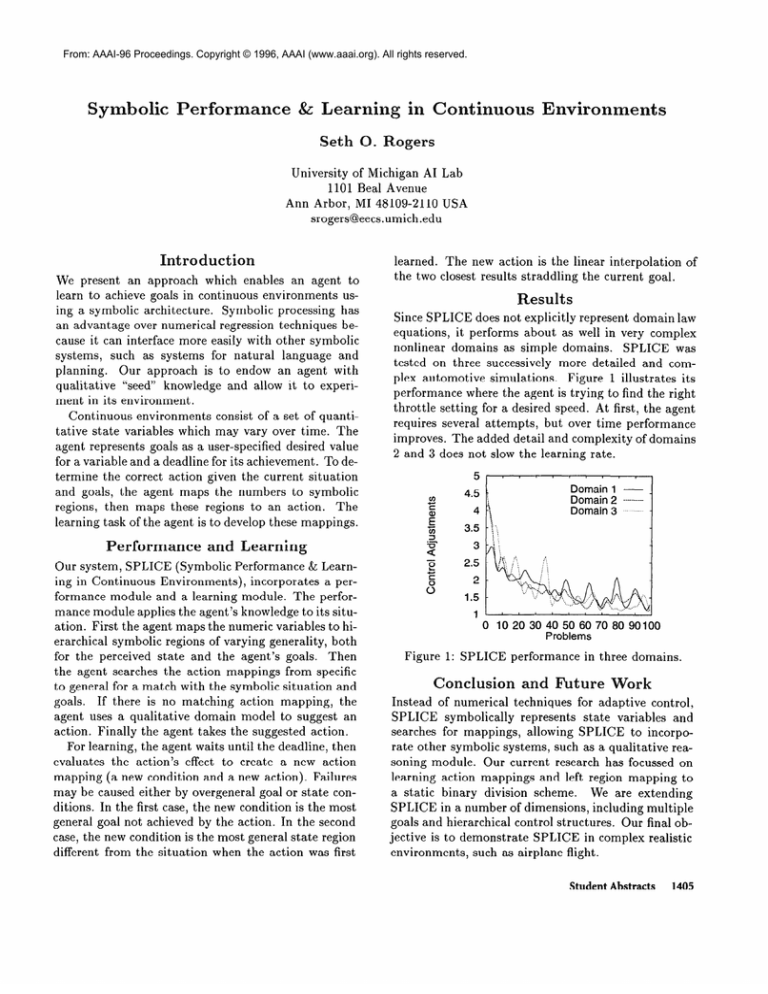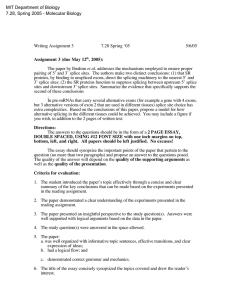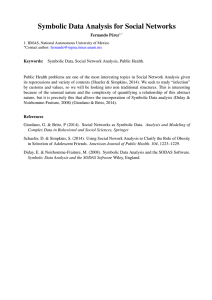Symbolic erformance & Learning in Continuous ... Seth 0. Rogers
advertisement

From: AAAI-96 Proceedings. Copyright © 1996, AAAI (www.aaai.org). All rights reserved. Symbolic erformance & Learning in Continuous Environ Seth 0. ents Rogers University of Michigan AI Lab 1101 Beal Avenue Ann Arbor, MI 48109-2110 USA srogers@eecs.umich.edu Introduction We present an approach which enables an agent to learn to achieve goals in continuous environments using a symbolic architecture. Symbolic processing has an advantage over numerical regression techniques because it can interface more easily with other symbolic systems, such as systems for natural language and planning. Our approach is to endow an agent with “seed” knowledge and allow it to experiqualitative ment in its environment. Continuous environments consist of a set of quantitative state variables which may vary over time. The agent represents goals as a user-specified desired value for a variable and a deadline for its achievement. To determine the correct action given the current situation and goals, the agent maps the numbers to symbolic The regions, then maps these regions to an action. learning task of the agent is to develop these mappings. Performance learned. The new action is the linear interpolation the two closest results straddling the current goal. of Results Since SPLICE does not explicitly represent domain law equations, it performs about as well in very complex nonlinear domains as simple domains. SPLICE was tested on three successively more detailed and complex automotive simulations. Figure 1 illustrates its performance where the agent is trying to find the right throttle setting for a desired speed. At first, the agent requires several attempts, but over time performance improves. The added detail and complexity of domains 2 and 3 does not slow the learning rate. Domain 1 Domain 2 -----Domain 3 4.5 i\, 4 \: and Learning Our system, SPLICE (Symbolic Performance & Learning in Continuous Environments), incorporates a performance module and a learning module. The performance module applies the agent’s knowledge to its situation. First the agent maps the numeric variables to hierarchical symbolic regions of varying generality, both for the perceived state and the agent’s goals. Then the agent searches the action mappings from specific to general for a match with the symbolic situation and goals. If there is no matching action mapping, the agent uses a qualitative domain model to suggest an action. Finally the agent takes the suggested action. For learning, the agent waits until the deadline, then evaluates the action’s effect to create a new action mapping (a new condition and a new action). Failures may be caused either by overgeneral goal or state conditions. In the first case, the new condition is the most general goal not achieved by the action. In the second case, the new condition is the most general state region different from the situation when the action was first 0 10 20 30 40 50 60 70 80 90 100 Problems Figure 1: SPLICE Conclusion performance in three domains. and Future Instead of numerical techniques for adaptive control, SPLICE symbolically represents state variables and searches for mappings, allowing SPLICE to incorporate other symbolic systems, such as a qualitative reasoning module. Our current research has focussed on learning action mappings and left region mapping to a static binary division scheme. We are extending SPLICE in a number of dimensions, including multiple goals and hierarchical control structures. Our final objective is to demonstrate SPLICE in complex realistic environments, such as airplane flight. Student Abstracts 1405



